Transform your lackluster window views into vibrant living spaces with strategic plant placement. You’ll discover how to select and arrange plants that not only enhance your home’s aesthetic but also serve practical purposes like air purification and fresh herbs for cooking. From low-maintenance succulents to dramatic trailing vines, each option offers unique benefits for different window conditions. Let’s explore how these eight distinctive approaches can revolutionize your window spaces.
Contents
Cascading Vines and Trailing Plants
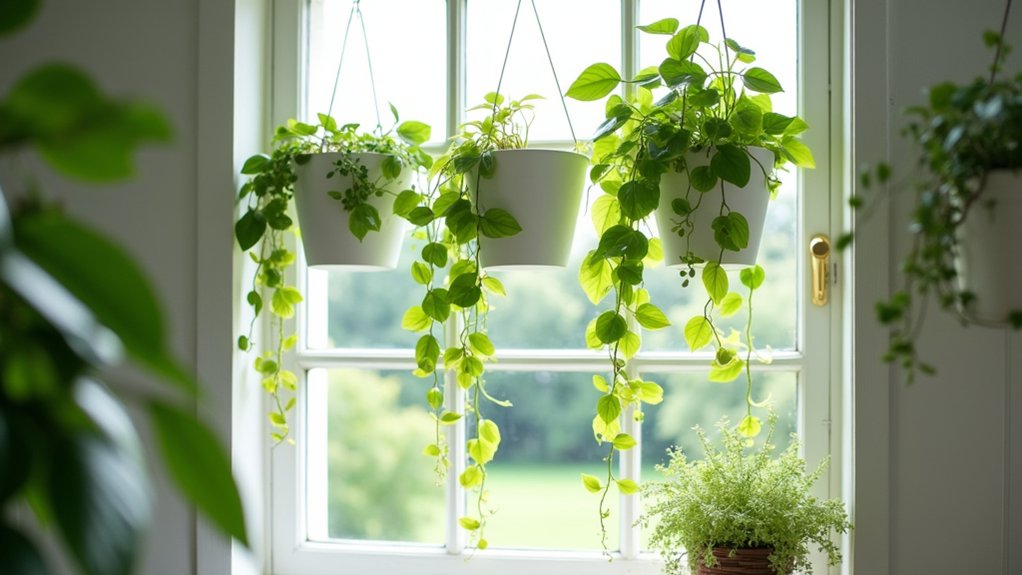
Cascading vines and trailing plants create a dramatic, living curtain effect when placed near windows, with their long stems and foliage gracefully spilling downward.
These plants, which include varieties like Pothos, String of Pearls, and English Ivy, add vertical interest and soften architectural lines while maximizing vertical space. Their flowing growth pattern naturally draws the eye downward, creating an elegant, organic display that can transform a simple window into a living art piece.
Growing Conditions:
- Light: Moderate to bright indirect light, avoiding harsh afternoon sun
- Water: Allow top inch of soil to dry between waterings
- Soil: Well-draining potting mix with good aeration
- Humidity: Moderate to high, depending on variety
- Temperature: 65-80°F (18-27°C)
- Container: Hanging baskets or elevated planters with drainage holes
Regular pruning and grooming are essential for maintaining healthy cascading plants and controlling their growth pattern.
Trim leggy or damaged vines to encourage fuller growth, and rotate containers quarterly to ensure even growth on all sides. Support longer vines with gentle ties or hooks if needed, and dust leaves monthly to maintain photosynthesis efficiency.
Remove yellow or dead foliage promptly to prevent disease spread and maintain the plant’s aesthetic appeal.
Compact Herb Gardens
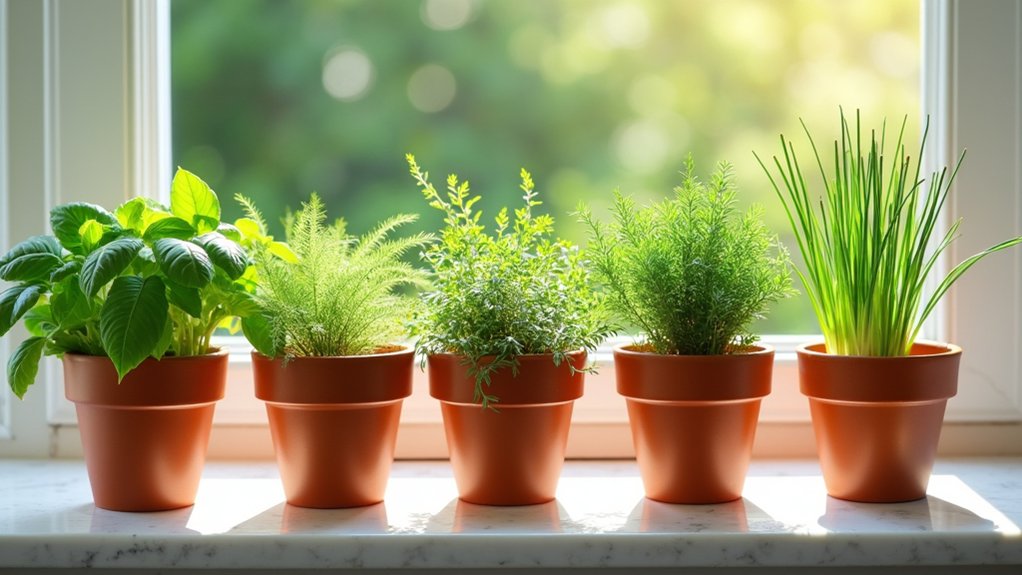
Compact herb gardens transform sunny windowsills into practical culinary spaces, featuring small clusters of essential cooking herbs like basil, thyme, chives, and parsley.
These miniature gardens typically consist of shallow containers arranged in a row or tiered configuration, creating an accessible and aromatic display that maximizes limited window space while providing fresh herbs year-round.
- Light: Minimum 6 hours of direct sunlight daily, preferably south-facing windows
- Water: Moderate watering when top inch of soil feels dry
- Soil: Well-draining potting mix enriched with organic matter
- Temperature: 65-70°F (18-21°C)
- Container: 6-8 inch deep pots with drainage holes
- Spacing: 4-6 inches between plants
- Humidity: Average indoor humidity levels (40-60%)
Regular pruning and harvesting are essential to maintain bushy growth and prevent herbs from becoming leggy or flowering prematurely.
Rotate containers quarterly to ensure even growth, and fertilize monthly during growing season with a balanced, water-soluble fertilizer diluted to half strength.
Remove any yellowing or dead leaves promptly to prevent disease spread, and ensure adequate air circulation between plants by avoiding overcrowding.
Air-Purifying Window Plants
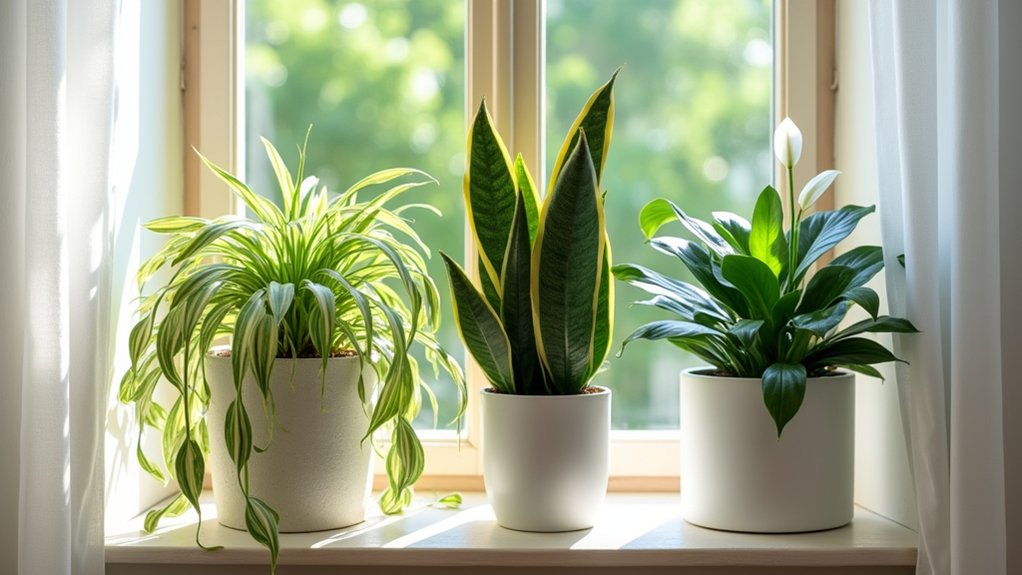
Air-purifying window plants are specially selected indoor species known for their ability to filter harmful pollutants from indoor air while thriving in window locations. Popular varieties include spider plants, snake plants, pothos, and peace lilies, which not only remove toxins like formaldehyde, benzene, and carbon monoxide but also add natural beauty to window spaces.
These plants typically feature broad leaves or multiple fronds to maximize their air-cleaning capabilities, and many display attractive variegated patterns or striking architectural forms.
- Light Requirements: Bright, indirect sunlight; avoid direct afternoon sun that can scorch leaves
- Water Needs: Moderate watering when top inch of soil feels dry
- Soil Type: Well-draining potting mix with good aeration
- Humidity: 40-60% relative humidity
- Temperature: 65-80°F (18-27°C)
- Container: Pots with drainage holes, sized appropriately for root growth
- Spacing: Allow adequate air circulation between plants
Regular dusting of leaves with a damp cloth ensures maximum air-purifying efficiency by keeping the pores unclogged.
Rotate plants quarterly to promote even growth and prevent leaning toward light sources. Inspect leaves weekly for signs of pests or disease, and maintain proper ventilation to prevent stagnant air around the plants.
Trim yellow or dead foliage promptly to maintain plant health and appearance.
Succulents and Cacti Displays
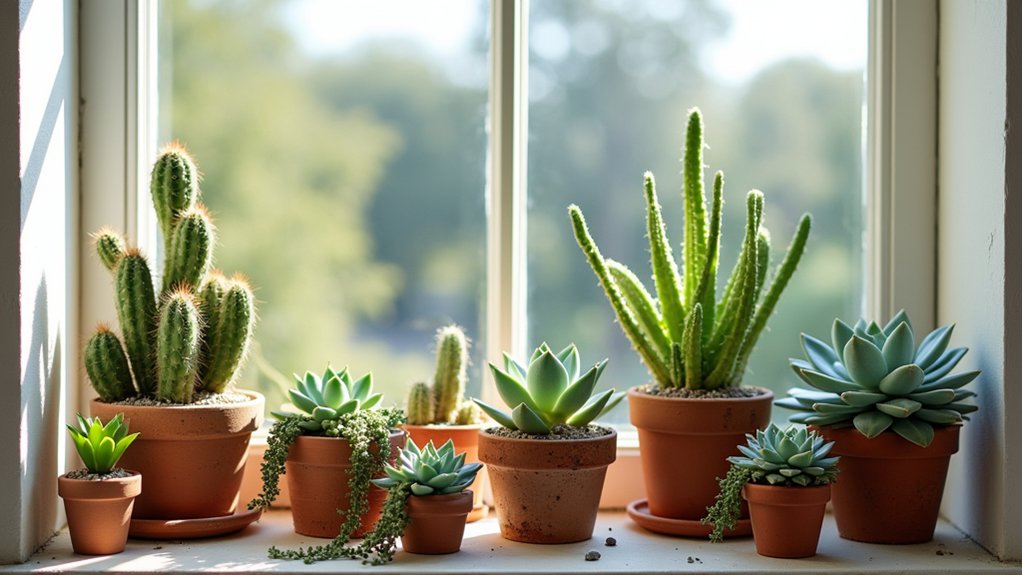
Succulents and cacti displays create striking windowsill arrangements with their diverse shapes, colors, and architectural forms. These water-wise plants range from compact rosettes and trailing varieties to tall, columnar specimens, offering endless creative possibilities for window decoration. Their thick, fleshy leaves and stems store water, giving them a distinctive appearance that adds both drama and simplicity to any window setting.
- Light: Bright, direct sunlight for 4-6 hours daily; south or west-facing windows are ideal
- Water: Allow soil to dry completely between waterings; reduce watering in winter
- Soil: Well-draining cactus mix or regular potting soil mixed with sand and perlite
- Temperature: 60-80°F (15-27°C); can tolerate temperature drops to 50°F (10°C)
- Humidity: Low to moderate; tolerates dry indoor air well
- Container: Pots with drainage holes; shallow containers for spreading varieties
To maintain healthy succulent and cacti displays, rotate containers quarterly to ensure even growth, as these plants tend to lean toward light sources.
Remove dead leaves promptly to prevent pest problems and fungal issues. Fertilize sparingly during the growing season (spring and summer) with a balanced, water-soluble fertilizer diluted to half strength.
Inspect regularly for common pests like mealybugs and spider mites, treating any issues immediately with insecticidal soap or rubbing alcohol.
Flowering Window Box Arrangements
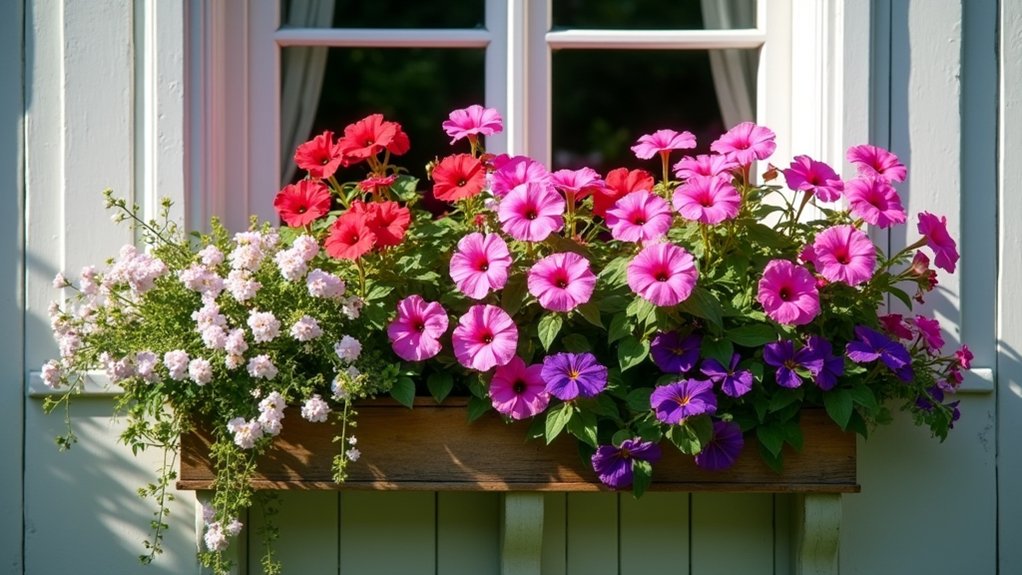
Flowering window box arrangements transform ordinary windows into vibrant displays of cascading blooms and complementary foliage. These arrangements typically feature a mix of trailing flowers, upright bloomers, and filler plants arranged in a “thriller, spiller, filler” pattern, creating depth and visual interest. Popular choices include petunias, geraniums, lobelia, and sweet alyssum, which can be combined to provide continuous color throughout the growing season.
- Full sun to partial shade, depending on flower selection (minimum 4-6 hours of direct sunlight for most flowering varieties)
- Well-draining potting soil enriched with organic matter
- Regular watering, typically daily during hot weather
- Container depth of at least 8 inches with drainage holes
- Spacing of 4-6 inches between plants
- Monthly balanced fertilizer application during growing season
- Protection from strong winds
- Temperature range of 60-75°F (15-24°C) for optimal blooming
Regular deadheading of spent blooms encourages continuous flowering and prevents seed formation. Trim back leggy growth to maintain shape and prevent plants from becoming too dense, which can restrict air circulation.
Monitor for signs of pest infestation or disease, especially in humid conditions, and treat promptly with appropriate measures. Replace seasonal arrangements as needed, typically switching between spring, summer, and fall combinations to maintain year-round appeal.
Vertical Garden Solutions
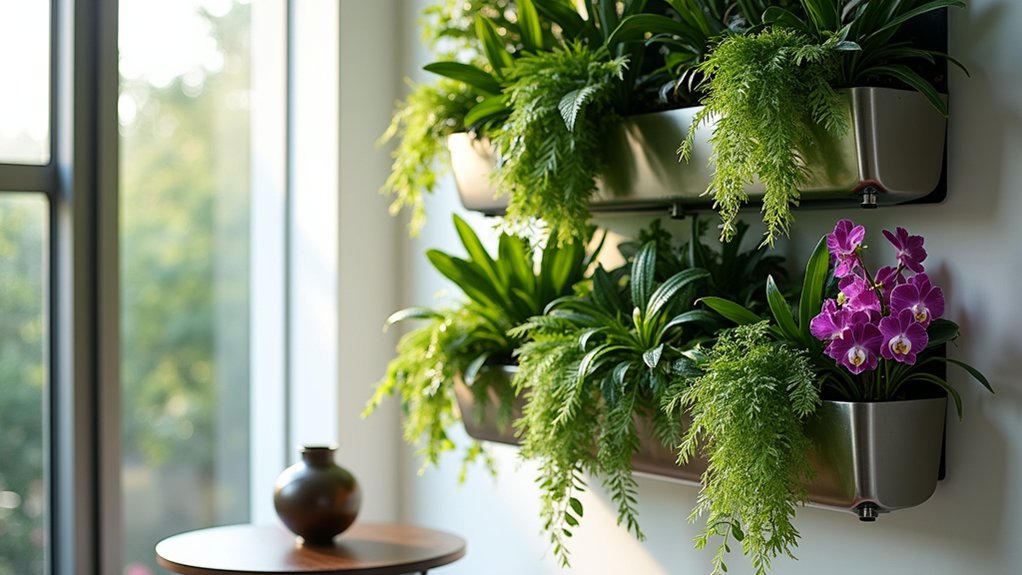
Vertical garden solutions transform window spaces into living walls of greenery, maximizing limited space while creating stunning visual impact.
These installations can range from simple hanging pocket planters to elaborate modular systems, featuring cascading vines, flowering plants, and compact herbs arranged in vertical rows or artistic patterns. The design possibilities are endless, allowing for both decorative and functional arrangements that bring nature indoors while maintaining an organized, space-efficient aesthetic.
- Light Requirements: Bright, indirect sunlight; morning sun preferred; avoid harsh afternoon sun exposure
- Water Needs: Regular watering schedule with good drainage system; bottom plants typically need less water than top ones
- Soil Type: Well-draining potting mix enriched with organic matter
- Temperature Range: 65-80°F (18-27°C)
- Humidity: Moderate to high, depending on plant selection
- Support Structure: Strong mounting system rated for weight when fully watered
Maintaining a vertical garden requires regular inspection of the support system and irrigation setup.
Prune plants to maintain desired shape and prevent overcrowding, focusing on removing dead or yellowing foliage. Rotate plants periodically if growth becomes uneven due to light exposure, and check mounting hardware monthly to ensure stability.
Monitor the moisture levels across different sections of the garden, as gravity can cause uneven water distribution, and adjust watering patterns accordingly. Fertilize with a balanced, water-soluble fertilizer during the growing season, applying at half-strength to prevent nutrient buildup.
Low-Light Window Plants
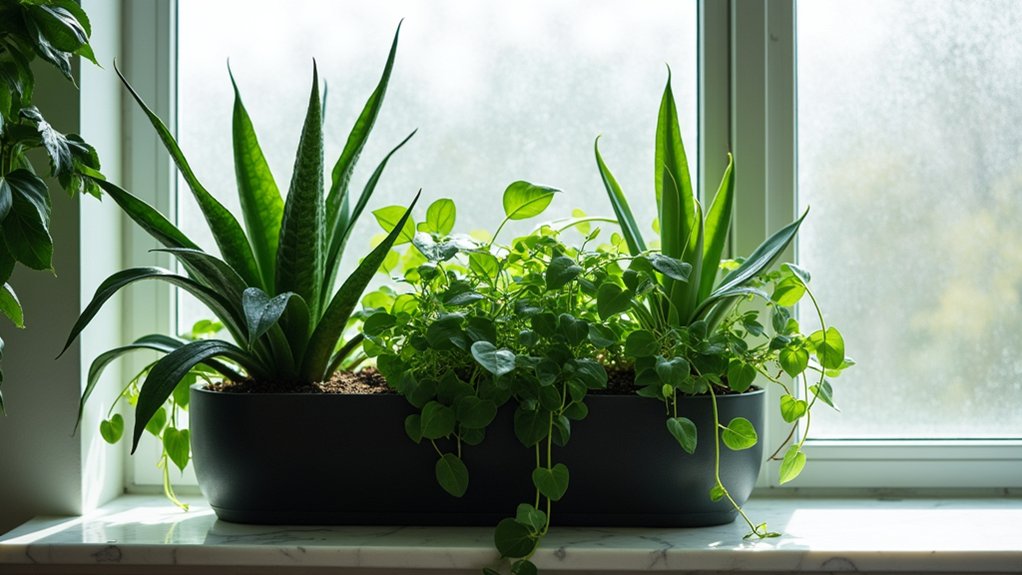
Low-light window plants are resilient indoor species that thrive in areas with minimal natural sunlight, making them perfect for north-facing windows or rooms with limited light exposure.
These plants typically feature broad, dark green leaves designed to maximize light absorption, and many exhibit slower growth patterns as an adaptation to lower light conditions. Common varieties include snake plants, ZZ plants, pothos, and peace lilies, which have evolved to flourish in the understory of dense forests.
- Light: 2-4 hours of indirect sunlight daily; can tolerate low-light conditions
- Water: Allow top 1-2 inches of soil to dry between waterings
- Soil: Well-draining potting mix with good aeration
- Temperature: 60-75°F (15-24°C)
- Humidity: 40-50% relative humidity
- Fertilizer: Light feeding every 2-3 months during growing season
- Container: Pots with drainage holes to prevent root rot
Regular dusting of leaves with a damp cloth helps maximize light absorption in low-light conditions.
Rotate plants quarterly to ensure even growth, and trim yellowing or dead foliage promptly to maintain plant health.
While these plants are tolerant of low light, avoid placing them in completely dark corners or areas with no natural light at all, as this can lead to leggy growth and eventual decline.
Monitor for signs of overwatering, which is a common issue with low-light plants since reduced light means slower water absorption.
Pet-Safe Window Garden Ideas
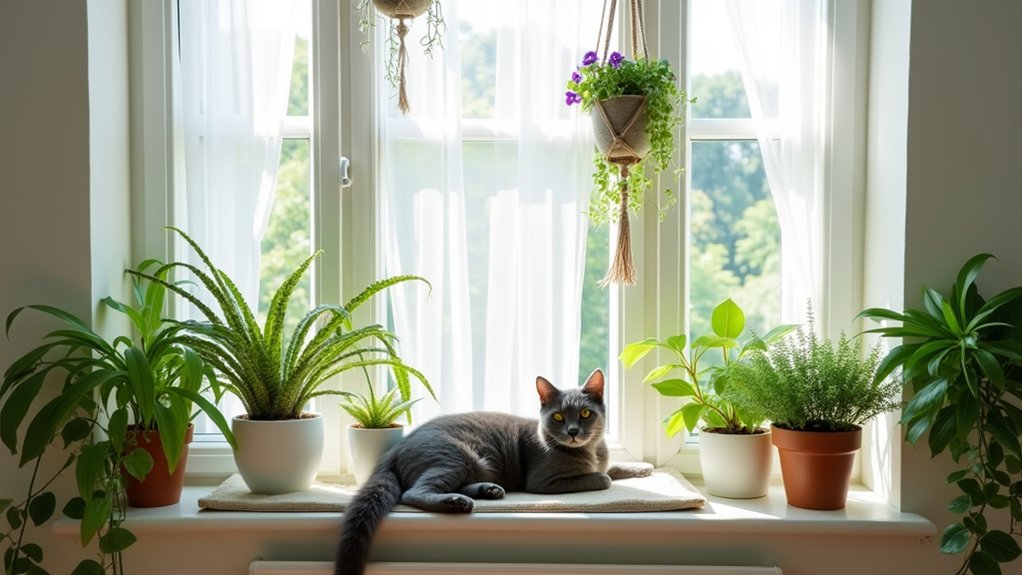
Pet-safe window gardens create a beautiful indoor oasis while ensuring the safety of curious cats and dogs. These specially curated plant collections feature non-toxic varieties like spider plants, Boston ferns, African violets, and calatheas, which can be arranged on windowsills or hanging planters to maximize natural light while keeping pets safe.
The combination of trailing and upright plants creates visual interest and allows pets to safely investigate without risk of poisoning.
- Light: Bright, indirect sunlight; morning sun is ideal
- Water: Moderate watering, allowing top inch of soil to dry between waterings
- Soil: Well-draining potting mix with good aeration
- Temperature: 65-75°F (18-24°C)
- Humidity: 40-60% for most pet-safe plants
- Container: Sturdy pots with drainage holes, secured to prevent tipping
- Spacing: 6-12 inches between plants to allow proper air circulation
Regular monitoring of plant-pet interactions and strategic placement are essential for maintaining a successful pet-safe window garden.
Remove any fallen leaves promptly, secure pots and hanging baskets firmly, and trim damaged foliage to discourage pets from playing with the plants.
Installing plant barriers or decorative rocks around pots can deter digging, while rotating plants periodically ensures even growth and maintains the garden’s attractive appearance.
